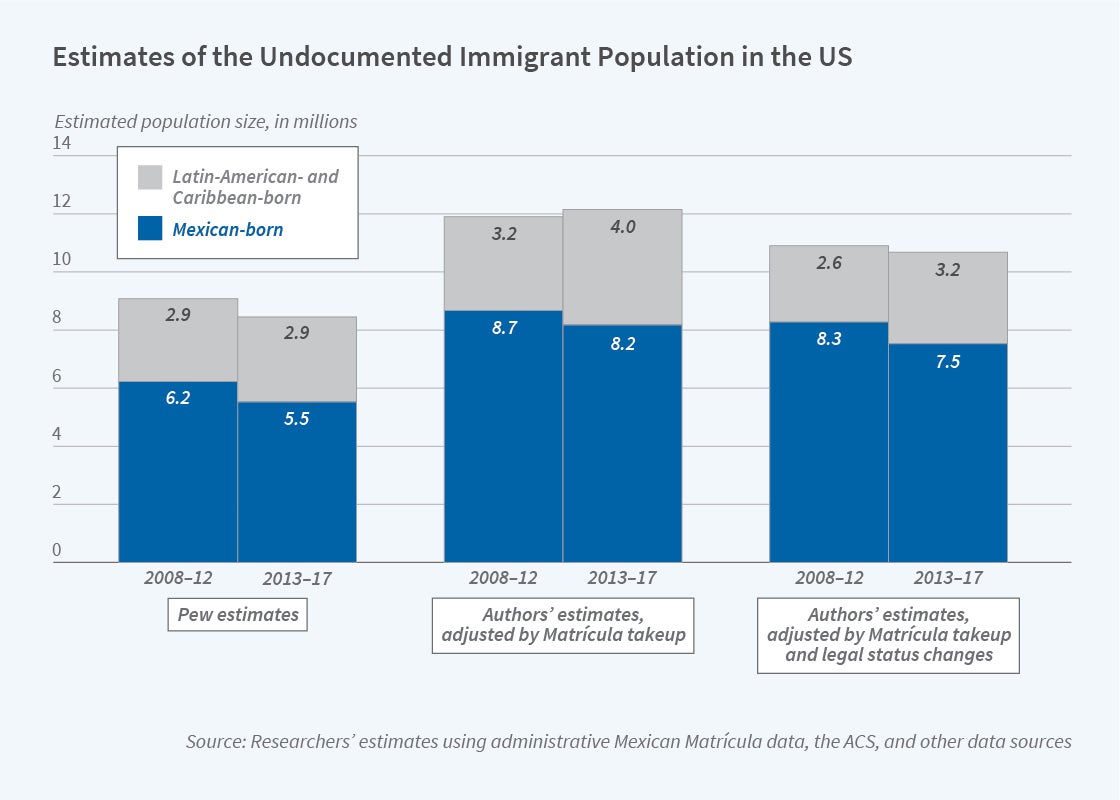Measuring the Undocumented and Legal Immigrant Populations in the US

Basic facts about the size of the immigrant population, the fraction undocumented, and future trends in these measures are crucial for analysis of Social Security and other public policies. However, there is a lack of quality data on the number of undocumented immigrants that reside in the US at a given point in time, as standard government surveys do not indicate a person’s legal status.
In Projecting Trends in Undocumented and Legal Immigrant Populations in the United States (NBER RDRC Working Paper NB21-16), researchers Ryan Bhandari, Benjamin Feigenberg, Darren Lubotsky, and Eduardo Medina-Cortina use new data to produce alternative measures of the undocumented population in the US and future population projections.
The authors use administrative data on over 9 million Matrícula identification cards issued by the Mexican government between 2008 and 2017 to its citizens who reside in the US. Applicants must visit a Mexican consulate in the US and provide documentation of their Mexican nationality, identity, and current place of residence. The cards can be used for identification in the US, including to interact with financial institutions, acquire a driver’s license in some states, and obtain a taxpayer identification number though the federal government.
Matrícula cards offer unique advantages for measuring the undocumented population. The cards are issued almost exclusively to undocumented immigrants, as they offer no benefits for those in the US legally. The cards must be renewed every five years, so they provide fairly current information. As administrative records, the cards are not subject to the concern that the undocumented may be less likely to participate in surveys. One disadvantage of these data is that not all undocumented immigrants acquire or regularly renew cards.
The authors use the Matrícula data to construct estimates of the Mexican-born undocumented population share across local areas and to estimate the total Mexican-born undocumented population at the national level. They then combine this with data from the American Community Survey to estimate the undocumented population that originates from countries other than Mexico.
The authors estimate that there were 8.3 to 8.7 million undocumented Mexican-born individuals in the US each year between 2008 and 2012, which is roughly 35 percent higher than the 6.2 million benchmark estimate by the Pew Research Center. They estimate that the undocumented population from Mexico was 7.5 to 8.2 million between 2013 and 2017, a 5-10 percent decline from the earlier period. They also estimate that there were 3.2 to 4.0 million undocumented individuals from other Latin American and Caribbean countries in the US in the more recent period, an estimate that is more closely aligned with the 2.9 million estimate from the Pew Center.
Finally, the authors project future changes in the legal and undocumented immigrant population. To do so, they build a model that relates migration flows to economic, demographic, and policy parameters. They project a modest rise in undocumented migration from Mexico and other Latin American and Caribbean countries over the next two decades, followed by a fall to its current level around 2060.
The authors conclude that the Matrícula data are a useful new source of information for estimating the size and characteristics of the undocumented population.
The research reported herein was performed pursuant to grant RDR18000003 from the US Social Security Administration (SSA) funded as part of the Retirement and Disability Research Consortium. The opinions and conclusions expressed are solely those of the author(s) and do not represent the opinions or policy of SSA, any agency of the Federal Government, or NBER. Neither the United States Government nor any agency thereof, nor any of their employees, makes any warranty, express or implied, or assumes any legal liability or responsibility for the accuracy, completeness, or usefulness of the contents of this report. Reference herein to any specific commercial product, process or service by trade name, trademark, manufacturer, or otherwise does not necessarily constitute or imply endorsement, recommendation or favoring by the United States Government or any agency thereof.


